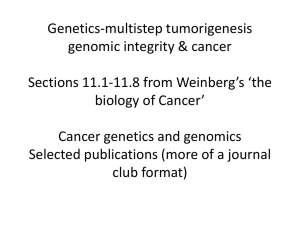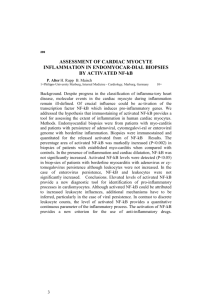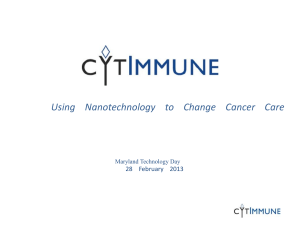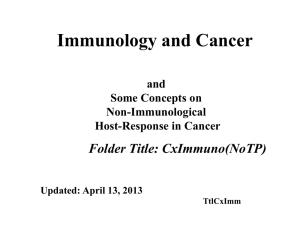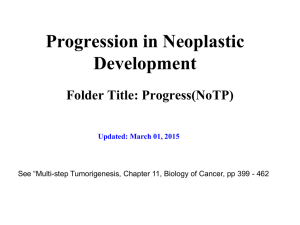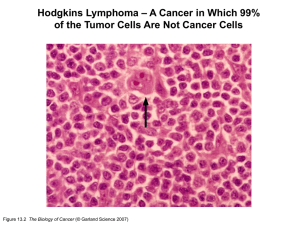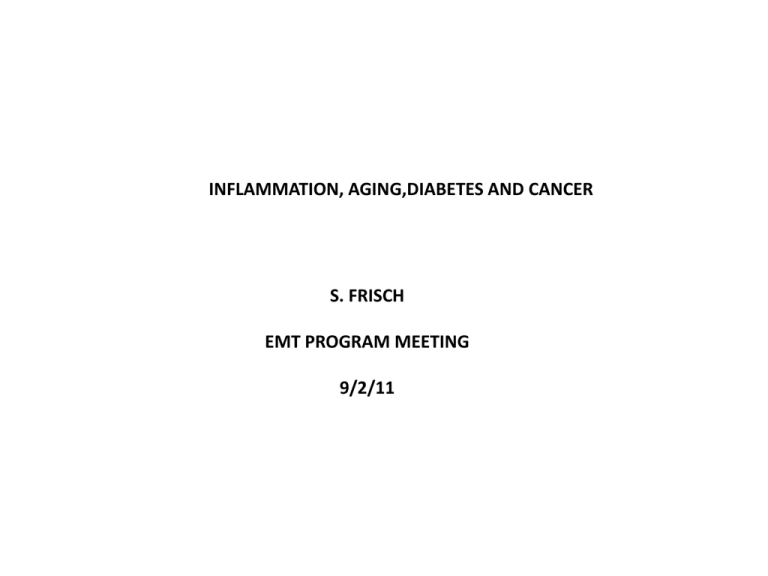
INFLAMMATION, AGING,DIABETES AND CANCER
S. FRISCH
EMT PROGRAM MEETING
9/2/11
CANCER IS A PREVENTABLE DISEASE!
OVERALL OUTLINE
1. INFLAMMATION CONTRIBUTES SIGNIFICANTLY TO CANCER
2.
A.
B.
C.
INFLAMMATORY REACTIONS ARE CAUSED BY:
PATHOGENS
NORMAL AGING
METABOLIC IMBALANCES : THE GH/INS/IGF
SIGNALING PATHWAY
D. THE TUMORS THEMSELVES (INC. MICROENVIRONMENT)
E. CHEMOTHERAPY/RADIATION
3. KEY MEDIATOR OF INFLAMMATION/AGING/CANCER: NF-kB
4.
A.
B.
C.
D.
KEY SUPPRESSORS OF NF-kB
SIRT PROTEINS
SUPPRESSORS OF THE GH/INS/IGF SIGNALING PATHWAY
NATURALLY OCCURRING DIETARY COMPONENTS (E.G. CURCUMIN)
COX INHIBITORS (DOWNSTREAM OF NF-KB)
Chronic inflammation associated with infections or autoimmune disease precedes tumor development and can contribute to it through induction
of oncogenic
mutations, genomic instability, early tumor promotion, and enhanced angiogenesis. Prolonged exposure to environmental irritants or obesity can
also result in
low-grade chronic inflammation that precedes tumor development and contributes to it through the mechanisms mentioned above. Tumorassociated inflammation
goes hand in hand with tumor development. This inflammatory response can enhance neoangiogenesis, promote tumor progression and
metastatic
spread, cause local immunosuppression, and further augment genomic instability. Cancer therapy can also trigger an inflammatory response by
causing trauma,
necrosis, and tissue injury that stimulate tumor re-emergence and resistance to therapy. However, in some cases, therapy-induced inflammation
can enhance
antigen presentation, leading to immune-mediated tumor eradication. Tumor-promoting mechanisms are in red and antitumorigenic mechanisms
are in blue.
PATHOGENSINFLAMMATIONCANCER
Figure 11.34a The Biology of Cancer (© Garland Science 2007)
PATHOGENSINFLAMMATIONCANCER
Figure 11.34b The Biology of Cancer (© Garland Science 2007)
INDUCTION OF PKCNF-KB CAUSES RECRUITMENT OF NEUTROPHILS
CYTOKINE PRODUCTIONINFLAMMATIONTUMOR PROMOTION
WT
Figure 11.36 The Biology of Cancer (© Garland Science 2007)
PKC-TRANSGENIC
MDR KObile acid accumulationinflammatory responserecruitment
of neutrophils
Figure 11.37a The Biology of Cancer (© Garland Science 2007)
Figure 11.37b The Biology of Cancer (© Garland Science 2007)
COX INHIBITORS SUPPRESS TUMORIGENICITY
(MMTV-PyV-MT tumors scored for apoptosis by TUNEL)
Figure 11.39a The Biology of Cancer (© Garland Science 2007)
Figure 11.41 The Biology of Cancer (© Garland Science 2007)
ASPIRIN USAGE EFFECTS ON CANCER RATES:
LUNG CANCER: 0.68
BREAST CANCER: 0.70
COLORECTAL CANCER: 0.35
PANCREATIC CANCER: 0.50
RTKs, Cytokine receptors
(e.g., GP130, TNFR1/2, IL1bR)
TARGET GENES:
1.CELL SURVIVAL:
c-FLIP, IAPs,Bcl-2,
Bcl-xl, survivin
2. PROINFLAMMATORY:
COX2,IL-6, IL-1b, IL-15
Figure 6.29a The Biology of Cancer (© Garland Science 2007)
NF-B interactions in cancer. NF-B interacts with many transcription factors and
transcriptional regulators. The interactions could be direct at the promoter, such as in
AP1,
HIF-1, Notch1, JunD, CREB, SP1 or off the promoter, such as STAT3, p53 or both. The
single-head arrow indicates activation, whereas the double-head arrow indicates
direct and
indirect activation. The blunt-end arrow indicates inhibition and negative regulation.
NF-kB important for EMT
EpRas cells +/-TGF-beta, +/-dnIkB
Figure 14.21 The Biology of Cancer (© Garland Science 2007)
NF-kB important for anoikis-resistancemetastasis
Curcumin sensitizes non-small cell lung cancer cell anoikis through reactive
oxygen species-mediated Bcl-2 downregulation.
Pongrakhananon V, Nimmannit U, Luanpitpong S, Rojanasakul Y,
Chanvorachote P.
Apoptosis. 2010 May;15(5):574-85.
NF-KB IN TUMOR CELL INVASION (621 REFERENCES!)
TNF-alpha/NF-kappaB/Snail pathway in cancer cell migration and
invasion.
Wu Y, Zhou BP.
Br J Cancer. 2010 Feb 16;102(4):639-44. Epub 2010 Jan 19.
Review.
DIABETES IS A MAJOR RISK FACTOR FOR CANCER!—WHY?
--Insulin inhibits IGFBP expression!
--Insulin promotes tumor development—been
known since 1972!! (type I diabetes models)
--breast cancer cells express an atypical variant of IGFR that binds insulin with high affinity
--IR is upregulated in breast cancer and in mouse models using wnt, neu
--total IR level in breast cancer inversely related to disease free survival
--although skeletal muscle becomes insulin-resistant in diabetes, epithelial cells
stay very insulin sensitive (which promotes their growth)
--adipose tissuenonesterified fatty acids to use as a carbon source—competes
with glucose and causes insulin resistance
--macrophages in adipose tissueIL-6, leptin, adiponectin,TNFinsulin resistance
IGFRANOIKIS RESISTANCE
Anti-apoptotic signaling of the IGF-I receptor in fibroblasts
following loss of matrix adhesion.
Valentinis B, Morrione A, Peruzzi F, Prisco M, Reiss K, Baserga R.
Oncogene. 1999 Mar 11;18(10):1827-36.
--high circulating levels of IGF-1 are associated with
Increased risk of breast, prostate and colorectal carcinoma
CANCER IS HIGHLY AGE-DEPENDENT!!
Figure 11.3 The Biology of Cancer (© Garland Science 2007)
“Insulin/IGF signaling enhances growth during development
but later in life can potentiate the aging process”
--GH-deficient mice live longer, have better glucose sensitivity
--caloric restriction lowers insulin, IGF levels
Several dauer genes (C. elegans) are homologous to components of IGF/Akt signaling
Pathway:
--DAF2 (=IR/IGFR)
--AGE1 (=PI3K)
--DAF16 (=FOXO)
--DAF18 (=PTEN)
IGFRs have major effects on longevity:
--IGFR-/+ mice live longer than wt
--IRS1-/- mice also live longer
--rapamycin treated mice live longer
--S6K1-/-mice live longer
Potential projects within MBRCC
(selected publications related to this topic—
A non-comprehensive list)
ROLE OF NF-KB IN ANOIKIS
curcumin
(SF lab, manuscript in
preparation)
NOVEL NF-KB SIGNALING MECHANISMS
Regulation of Fas (CD95)-induced apoptosis by nuclear factor-kappaB and
tumor necrosis factor-alpha in macrophages.
Lu B, Wang L, Medan D, Toledo D, Huang C, Chen F, Shi X, Rojanasakul Y.
Am J Physiol Cell Physiol. 2002 Sep;283(3):C831-8.
Antioxidant c-FLIP Inhibits Fas Ligand-Induced NF-{kappa}B Activation
in a Phosphatidylinositol 3-Kinase/Akt-Dependent Manner.
Iyer AK, Azad N, Talbot S, Stehlik C, Lu B, Wang L, Rojanasakul Y.
J Immunol. 2011 Aug 19. [Epub ahead of print]
(YR lab)
Inhibition of nuclear transcription factor-kappaB by specific IkappaB kinase
peptide inhibitor.
Swaroop N, Chen F, Wang L, Dokka S, Toledo D, Rojanasakul Y.
Pharm Res. 2001 Nov;18(11):1631-3. No abstract available.
OBESITY, INFLAMMATION, BREAST CANCER
Triple-negative breast cancer and obesity in a rural Appalachian population.
Vona-Davis L, Rose DP, Hazard H, Howard-McNatt M, Adkins F, Partin J, Hobbs G.
Cancer Epidemiol Biomarkers Prev. 2008 Dec;17(12):3319-24.
Adiposity, type 2 diabetes and the metabolic syndrome in breast
cancer.
Vona-Davis L, Howard-McNatt M, Rose DP.
Obes Rev. 2007 Sep;8(5):395-408. Review.
(LVD lab)
Peptide YY reverses TNF-alpha induced transcription factor binding of interferon
regulatory factor-1 and p53 in pancreatic acinar cells.
Rizvi IA, Robinson K, McFadden DW, Riggs DR, Jackson BJ, Vona-Davis L.
J Surg Res. 2006 Nov;136(1):25-30. Epub 2006 Sep 15.
CONTROL OF LIPID BIOSYNTHESIS
Fibroblast growth factor-19, a novel factor that inhibits hepatic fatty
acid synthesis.
Bhatnagar S, Damron HA, Hillgartner FB.
J Biol Chem. 2009 Apr 10;284(15):10023-33. Epub 2009 Feb 20.
The mechanism mediating the activation of acetyl-coenzyme A
carboxylase-alpha gene transcription by the liver X receptor
agonist T0-901317.
Talukdar S, Hillgartner FB.
J Lipid Res. 2006 Nov;47(11):2451-61. Epub 2006 Aug 24.
Role of CCAAT/enhancer-binding protein, histone acetylation, and
coactivator recruitment in the regulation of malic enzyme transcription
by thyroid hormone.
Yin L, Wang Y, Dridi S, Vinson C, Hillgartner FB.
Mol Cell Endocrinol. 2005 Dec 21;245(1-2):43-52. Epub 2005 Nov 15.
Acetyl-CoA carboxylase-a as a novel target for cancer therapy.
Also: see
Wang C, Rajput S, Watabe K, Liao DF, Cao D.
Front Biosci (Schol Ed). 2010 Jan 1;2:515-26. Review.
Fatty acid synthase as a potential therapeutic target in cancer.
Flavin R, Peluso S, Nguyen PL, Loda M.
Future Oncol. 2010 Apr;6(4):551-62. Review.
(FBH lab)
AMPK and FA Synthesis
Biochem Biophys Res Commun. 2009 Oct 9;388(1):117-21. Epub
2009 Jul 30.
A role for AMPK in the inhibition of glucose-6-phosphate
dehydrogenase by polyunsaturated fatty acids.
Kohan AB, Talukdar I, Walsh CM, Salati LM.
(LS lab)
AMPK as a metabolic tumor suppressor: control of
metabolism and cell growth.
Also see: Luo Z, Zang M, Guo W.
Future Oncol. 2010 Mar;6(3):457-70. Review.

